The Cambridge History of China. Vol. 06. Alien Regimes and Border States, 907-1368
Подождите немного. Документ загружается.

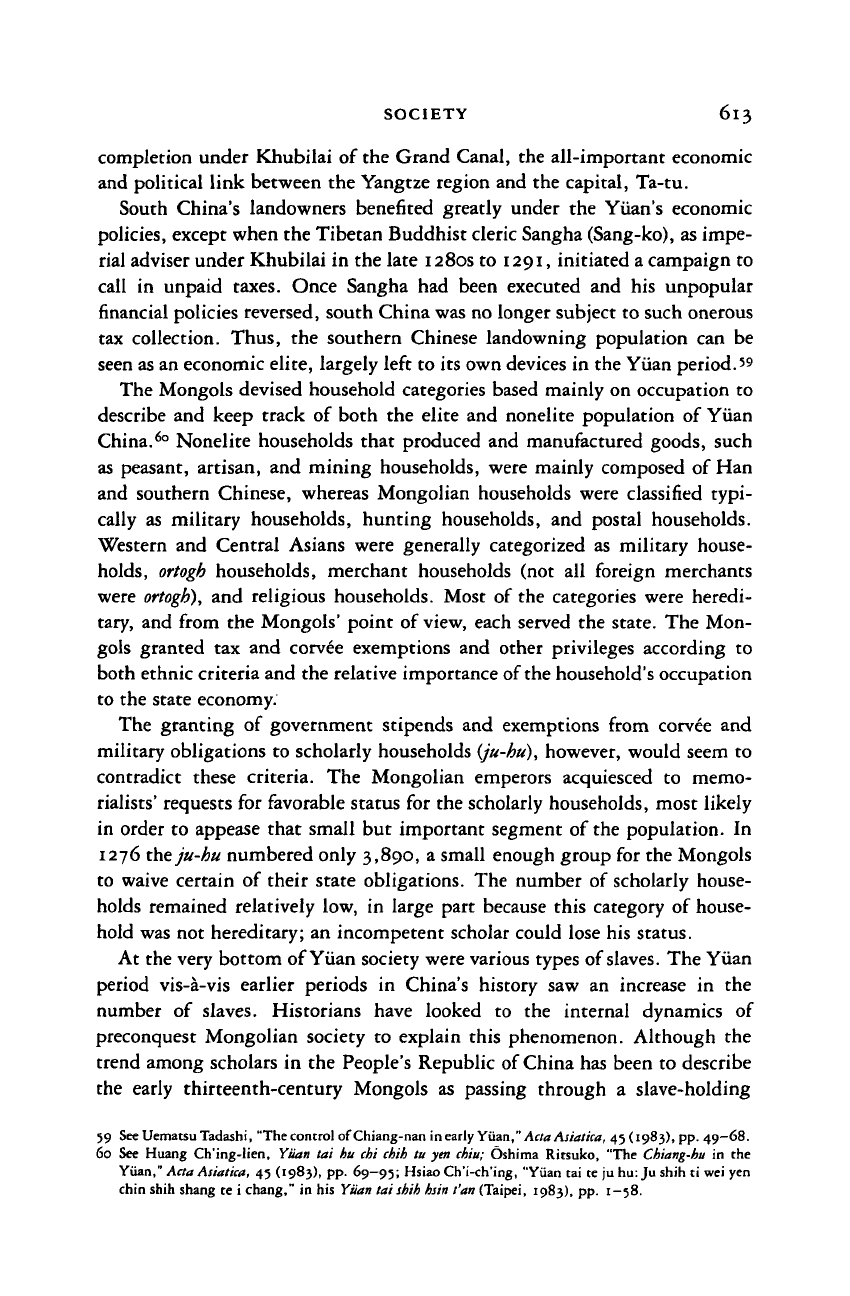
SOCIETY
613
completion under Khubilai of the Grand Canal, the all-important economic
and political link between the Yangtze region and the capital, Ta-tu.
South China's landowners benefited greatly under the Yiian's economic
policies, except when the Tibetan Buddhist cleric Sangha (Sang-ko), as impe-
rial adviser under Khubilai in the late 1280s to 1291, initiated a campaign to
call in unpaid taxes. Once Sangha had been executed and his unpopular
financial policies reversed, south China was no longer subject to such onerous
tax collection. Thus, the southern Chinese landowning population can be
seen as an economic elite, largely left to its own devices in the Yiian period.
59
The Mongols devised household categories based mainly on occupation to
describe and keep track of both the elite and nonelite population of Yiian
China.
6
° Nonelite households that produced and manufactured goods, such
as peasant, artisan, and mining households, were mainly composed of Han
and southern Chinese, whereas Mongolian households were classified typi-
cally as military households, hunting households, and postal households.
Western and Central Asians were generally categorized as military house-
holds,
ortogh households, merchant households (not all foreign merchants
were
ortogh),
and religious households. Most of the categories were heredi-
tary, and from the Mongols' point of view, each served the state. The Mon-
gols granted tax and corvee exemptions and other privileges according to
both ethnic criteria and the relative importance of the household's occupation
to the state economy.
The granting of government stipends and exemptions from corvee and
military obligations to scholarly households (ju-hu), however, would seem to
contradict these criteria. The Mongolian emperors acquiesced to memo-
rialists' requests for favorable status for the scholarly households, most likely
in order to appease that small but important segment of the population. In
1276 the ju-hu numbered only 3,890, a small enough group for the Mongols
to waive certain of their state obligations. The number of scholarly house-
holds remained relatively low, in large part because this category of house-
hold was not hereditary; an incompetent scholar could lose his status.
At the very bottom of Yiian society were various types of
slaves.
The Yiian
period vis-a-vis earlier periods in China's history saw an increase in the
number of slaves. Historians have looked to the internal dynamics of
preconquest Mongolian society to explain this phenomenon. Although the
trend among scholars in the People's Republic of China has been to describe
the early thirteenth-century Mongols as passing through a slave-holding
59 See Uematsu Tadashi, "The control of Chiang-nan in early Yiian," Ada Aliatica, 45(1983), pp. 49-68.
60 See Huang Ch'ing-lien, Yiian lai hu chi chih tu yen chiu; Oshima Ritsuko, "The Chiang-hu in the
Yiian," Ada Asialica, 45 (1983), pp. 69—95; Hsiao Ch'i-ch'ing, "Yiian tai te ju hu: Ju shih ti wei yen
chin shih shang te i chang," in his Yiian tai shib hsin t'an (Taipei, 1983), pp. 1—58.
Cambridge Histories Online © Cambridge University Press, 2008

614 THE YOAN GOVERNMENT AND SOCIETY
stage on the way to an early stage of feudalism in the linear Marxist scheme of
historically determined socioeconomic stages of development through which
all peoples pass, Soviet and Mongolian People's Republic scholars resolutely
hold that the Mongols skipped the slave-holding stage, thus moving directly
from a clan to a feudal society.
6l
Although these debates are not of direct
interest to us here, they do exemplify the difficulty that historians experience
in describing the role of slaves in early Mongolian society. Although the
thirteenth-century Mongols did indeed have slaves
—
usually non-Mongolian
war captives rather than indigenous slaves
—
it would not be correct to
describe slave holding as a fundamental characteristic of the Mongols' tribal
and clan-based pastoral nomadic society and economy.
Slavery was of particular importance to the economy of Mongolian soldiers
in Yuan China.
62
The Mongols kept captives from military campaigns, and
many of these captive slaves
(ch'ii-k'ou)
and their families were allocated to
soldiers for use in cultivating their lands, as Mongolian soldiers were loath to
till the soil themselves. Many of the captive slaves were Chinese, and by the
turn of the fourteenth century, so many of these captive slaves had run away
that Mongolian military households became impoverished, and ironically,
Mongolian men and women themselves began to be exported as slaves to
India and Islamic countries, starting as early as the late thirteenth century.
Although most slaves in Yuan China were thirteenth-century prisoners of
war, there also is evidence of the continuing enslavement, as well as the
buying and selling, of slaves throughout the Yuan period. Some were cap-
tives taken during internal rebellions, but others were apparently just arbi-
trary victims enslaved by officials and soldiers. Contemporary Yuan observers
deplored the existence of
slave
markets in Ta-tu, remarking that people were
being treated like cattle. To the Mongols, however, the category of
slave
was
indeed connected conceptually with ownership of animate and inanimate
objects. This is demonstrated by the existence of
the
so-called Agency of Men
and Things Gone Astray (Lan-i-chien), in which the disposition of runaway
slaves, lost material goods, and lost cattle was not differentiated.
Yuan government and society reflect both continuities and breaks with the
Chinese past. Yuan political institutions and styles of governance were based
on Mongolian, Inner Asian, and Chinese precedents, often difficult to disen-
61 See, for instance, Kao Wen-te,
Meng-ku
tin li
chih yen chiu
(Koke Khota, 1980); and Lu Ming-hui, "San
shih nien lai Chung-kuo Meng-ku shih yen chiu kai k'uang," in Meng-ku shih yen chiu lun wen chi, ed.
Lu Ming-hui et al. (Peking, 1984), pp. 240—3. On the treatment of Mongolian social development
and Yuan history in the Soviet Union and the Mongolian People's Republic, see Elizabeth Endicott-
West, "The Yuan," in Soviet
studies
of
premodem
China, ed. Gilbert Rozman (Ann Arbor, 1984), pp.
97-110.
62 See Hsiao, The military establishment of the Yiian dynasty, pp. 21, 29—30; and Tetsuo Ebisawa,
"Bondservants in the Yiian," Ada Asiatica, 45 (1983), pp. 27—48. The Japanese scholarship on slaves
in Yiian China is extensive.
Cambridge Histories Online © Cambridge University Press, 2008

SOCIETY 615
tangle from one another. The Mongols often used Chinese means to achieve
specifically Mongolian goals (e.g., the use of the Chinese hereditary yin
privilege to maintain ethnic elites) and again used Mongolian means to
achieve goals that any dynasty on Chinese soil inevitably strove to attain (as
in the establishment of the Mongolian office of
darughachi
to oversee local
government).
The particular needs of the Mongolian ruling elite led to governing mea-
sures that probably would not have arisen indigenously. Historians of Yuan
China continue to assess the unique elements in Mongolian rule, or more
specifically, to define what constituted "un-Chinese" (actual or perceived)
ways of
governance.
Identifying, explaining, and assessing Yuan governmen-
tal institutions and social practices reconfirm for historians the distinctive
character of the era of Mongolian rule.
Cambridge Histories Online © Cambridge University Press, 2008
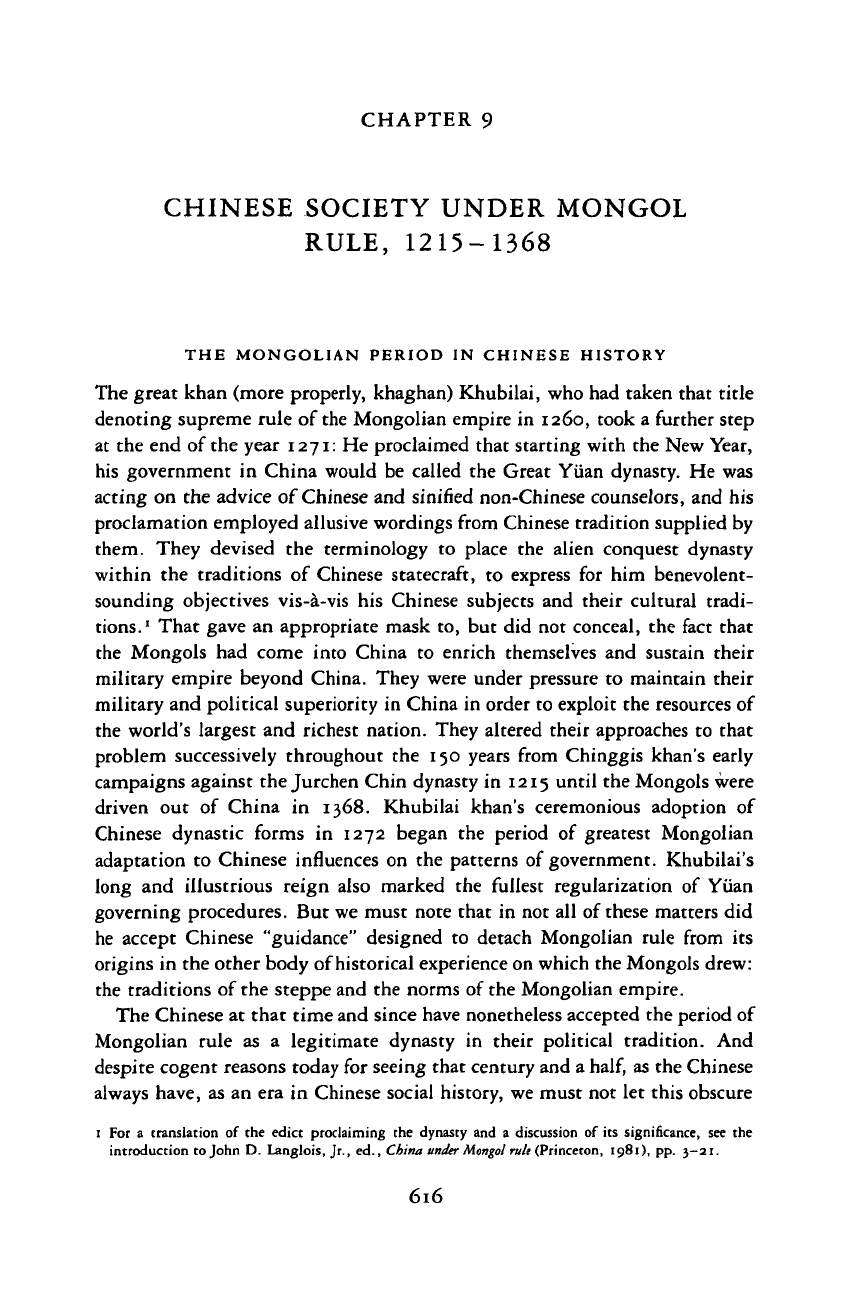
CHAPTER
9
CHINESE SOCIETY UNDER MONGOL
RULE, 1215-1368
THE MONGOLIAN PERIOD IN CHINESE HISTORY
The great khan (more properly, khaghan) Khubilai, who
had
taken that title
denoting supreme rule
of
the Mongolian empire
in
1260, took
a
further step
at
the end
of
the year
1271:
He
proclaimed that starting with
the
New Year,
his government
in
China would
be
called
the
Great Yuan dynasty.
He was
acting
on
the
advice
of
Chinese
and
sinified non-Chinese counselors,
and
his
proclamation employed allusive wordings from Chinese tradition supplied by
them. They devised
the
terminology
to
place
the
alien conquest dynasty
within
the
traditions
of
Chinese statecraft,
to
express
for him
benevolent-
sounding objectives vis-a-vis
his
Chinese subjects
and
their cultural tradi-
tions.
1
That gave
an
appropriate mask
to, but did not
conceal,
the
fact that
the Mongols
had
come into China
to
enrich themselves
and
sustain their
military empire beyond China. They were under pressure
to
maintain their
military
and
political superiority
in
China
in
order
to
exploit
the
resources of
the world's largest
and
richest nation. They altered their approaches
to
that
problem successively throughout
the 150
years from Chinggis khan's early
campaigns against the Jurchen Chin dynasty
in
1215 until the Mongols were
driven
out of
China
in 1368.
Khubilai khan's ceremonious adoption
of
Chinese dynastic forms
in 1272
began
the
period
of
greatest Mongolian
adaptation
to
Chinese influences
on the
patterns
of
government. Khubilai's
long
and
illustrious reign also marked
the
fullest regularization
of
Yuan
governing procedures.
But
we must note that
in not all
of
these matters
did
he accept Chinese "guidance" designed
to
detach Mongolian rule from
its
origins
in
the other body of historical experience on which the Mongols drew:
the traditions
of
the steppe and
the
norms
of
the Mongolian empire.
The Chinese
at
that time and since have nonetheless accepted the period of
Mongolian rule
as a
legitimate dynasty
in
their political tradition.
And
despite cogent reasons today
for
seeing that century and a
half,
as the Chinese
always have,
as an era in
Chinese social history, we must
not let
this obscure
1
For a
translation
of the
edict proclaiming
the
dynasty
and a
discussion
of its
significance,
see the
introduction to John
D.
Langlois,
Jr.,
ed.,
China under Mongol rule
(Princeton, 1981),
pp.
3-21.
6l6
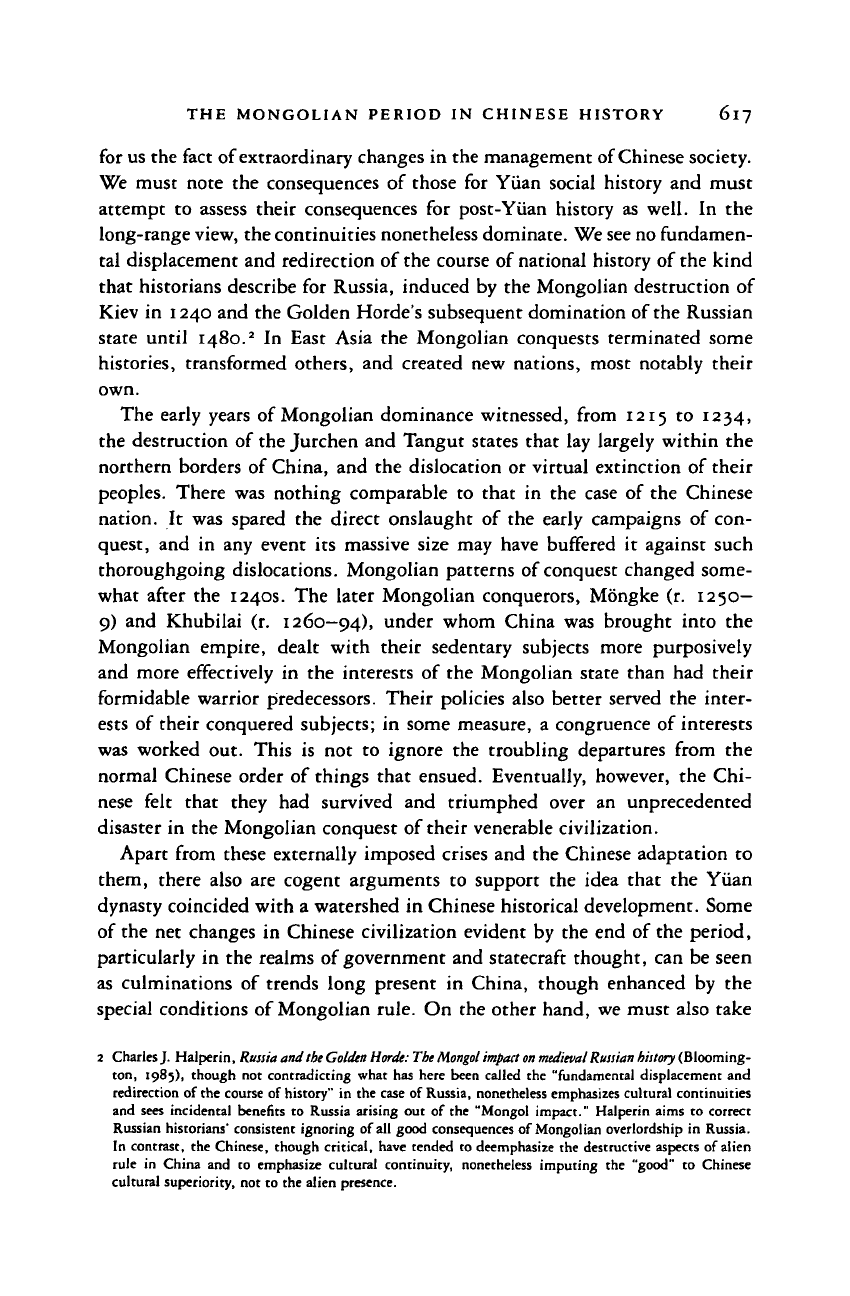
THE MONGOLIAN PERIOD IN CHINESE HISTORY 617
for us the fact of extraordinary changes in the management of Chinese society.
We must note the consequences of those for Yuan social history and must
attempt to assess their consequences for post-Yuan history as well. In the
long-range
view,
the continuities nonetheless dominate. We
see
no fundamen-
tal displacement and redirection of the course of national history of the kind
that historians describe for Russia, induced by the Mongolian destruction of
Kiev in 1240 and the Golden Horde's subsequent domination of the Russian
state until 1480.
2
In East Asia the Mongolian conquests terminated some
histories, transformed others, and created new nations, most notably their
own.
The early years of Mongolian dominance witnessed, from 1215 to 1234,
the destruction of the Jurchen and Tangut states that lay largely within the
northern borders of China, and the dislocation or virtual extinction of their
peoples. There was nothing comparable to that
in
the case of the Chinese
nation.
It
was spared the direct onslaught of the early campaigns of con-
quest, and in any event its massive size may have buffered
it
against such
thoroughgoing dislocations. Mongolian patterns of conquest changed some-
what after the 1240s. The later Mongolian conquerors, Mongke (r. 1250-
9) and Khubilai (r. 1260-94), under whom China was brought into the
Mongolian empire, dealt with their sedentary subjects more purposively
and more effectively in the interests of the Mongolian state than had their
formidable warrior predecessors. Their policies also better served the inter-
ests of their conquered subjects; in some measure, a congruence of interests
was worked out. This
is
not to ignore the troubling departures from the
normal Chinese order of things that ensued. Eventually, however, the Chi-
nese felt that they had survived and triumphed over
an
unprecedented
disaster in the Mongolian conquest of their venerable civilization.
Apart from these externally imposed crises and the Chinese adaptation to
them, there also are cogent arguments to support the idea that the Yuan
dynasty coincided with a watershed in Chinese historical development. Some
of the net changes in Chinese civilization evident by the end of the period,
particularly in the realms of government and statecraft thought, can be seen
as culminations of trends long present in China, though enhanced by the
special conditions of Mongolian rule. On the other hand, we must also take
2 Charles
J.
Halperin,
Russia
and
the Golden
Horde:
The Mongol impact on medieval Russian history
(Blooming-
ton,
198;), though not contradicting what has here been called the "fundamental displacement and
redirection of the course of history" in the case of Russia, nonetheless emphasizes cultural continuities
and sees incidental benefits
to
Russia arising out of the "Mongol impact." Halperin aims to correct
Russian historians' consistent ignoring of all good consequences of Mongolian overlordship in Russia.
In contrast, the Chinese, though critical, have tended to deemphasize the destructive aspects of alien
rule
in
China and
to
emphasize cultural continuity, nonetheless imputing the "good"
to
Chinese
cultural superiority, not to the alien presence.

6l8 CHINESE SOCIETY UNDER MONGOL RULE
account
of
the disruptive change and the varied Chinese responses to all
the
new factors introduced by the alien presence. The point of view adopted here
is that the latter, the set of circumstances directly attributable to the Mongo-
lian overlordship, accounts for much
in
both political and social history.
It
is
more difficult
to
marshal supporting evidence from the life
of
the society
at
large than
it
is from the political sphere. This chapter will attempt to suggest
the kinds of
issues
in social history that give the Yuan dynasty its interest and
importance
in
the minds of historians today.
THE POPULATION OF YUAN CHINA
Some of
the
most basic facts about Yuan society remain subject to speculation
and debate. The most glaring example
is
the uncertainty about the size and
distribution
of
the Chinese population.
A
later section
of
this chapter will
show that
the
Yuan government went beyond
all
precedent
in its
effort
to
classify and register its subjects according to status and occupation,
in
order
to serve its social management objectives. The actual counting of households
and individuals, nonetheless, was less directly relevant
to the
Yuan fiscal
system than
it had
been under Chinese dynasties,
and the
administrative
machinery responsible for the census, taxation, and land registration was not
notably efficient. The quality of these data is thus more than usually suspect.
Historical demographers point
to
the figures from
a
census
in
1290, late
in
the reign
of
Khubilai khan,
as the
most reliable
of
the Yuan period.
As
reported
in
the
Yuan
shih,*
it registered 13.19 million households containing
58,834,711 persons (see Map 37).
The historians note, however, that
no
figures
are
given
for the
newly
conquered province
of
Yunnan,
for a
number of widely scattered prefectural
and county level administrative units, for people "dwelling in mountains and
marshes" and other remote places,
or for
several large categories
of
residents
such
as
monks
and
priests,
the
military,
and
households
in
bondage
to
appanages.
The only other nationwide figures from the Yuan following the conquest
of the Southern Sung are supposedly from
a
new census dated 1330; they
show
an
insignificant increase,
and
there
is
reason
to
believe that they
are
largely figures carried over from 1290,
not the
result
of
a new census.
The
number of individuals per household
in
the 1290 census
figures
is about 4.5,
low but not impossible. It seems plausible that the population of Yuan China
shortly after the conquest of Southern Sung
in
the 1270s was
in
the range of
65 million persons.
The
1290 figures closely match those provided
by the
3 Sung Lien
et
al., eds.. Yuan shih(Peking, 1976),
58, p.
1346 (hereafter cited as
YS).
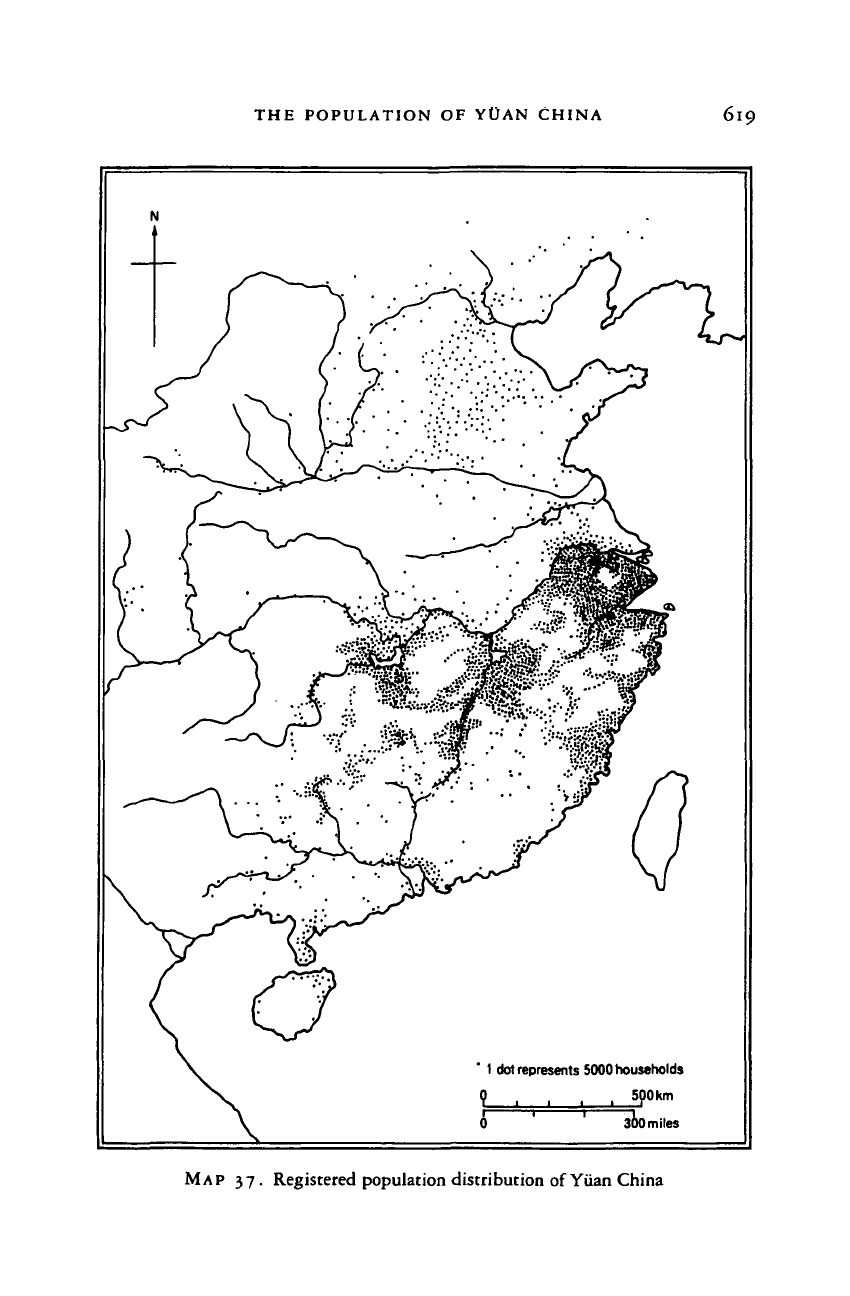
THE POPULATION OF YUAN CHINA 619
1 dot represents 5000 households
MAP
37. Registered population distribution of
Yiian
China
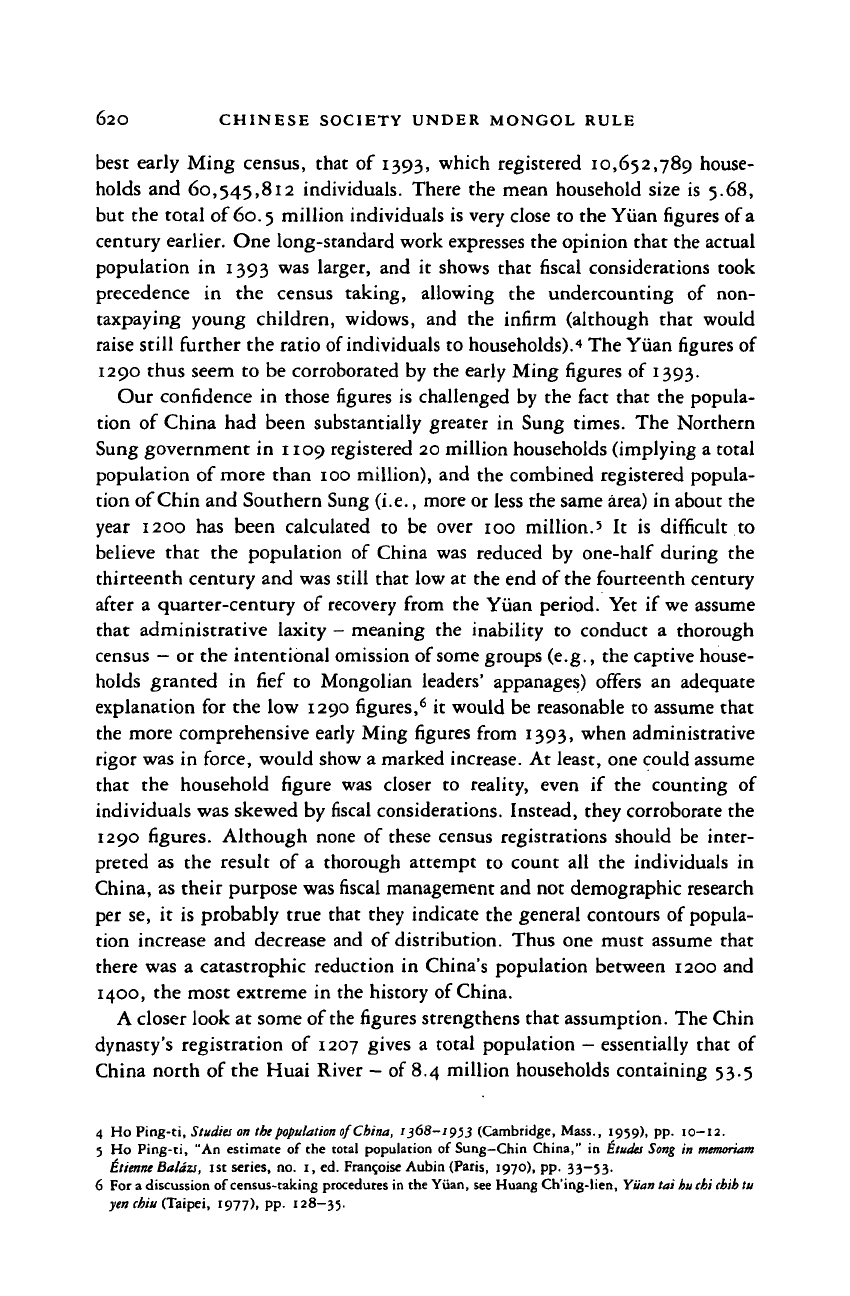
62O CHINESE SOCIETY UNDER MONGOL RULE
best early Ming census, that of 1393, which registered 10,652,789 house-
holds and 60,545,812 individuals. There the mean household size is 5.68,
but the total of 60.5 million individuals is very close to the Yiian
figures
of a
century earlier. One long-standard work expresses the opinion that the actual
population in 1393 was larger, and it shows that fiscal considerations took
precedence in the census taking, allowing the undercounting of non-
taxpaying young children, widows, and the infirm (although that would
raise still further the ratio of individuals to households).
4
The Yiian
figures
of
1290 thus seem to be corroborated by the early Ming figures of 1393.
Our confidence in those figures is challenged by the fact that the popula-
tion of China had been substantially greater in Sung times. The Northern
Sung government in 1109 registered 20 million households (implying a total
population of more than 100 million), and the combined registered popula-
tion of Chin and Southern Sung (i.e., more or less the same area) in about the
year 1200 has been calculated to be over 100 million.' It is difficult to
believe that the population of China was reduced by one-half during the
thirteenth century and was still that low at the end of the fourteenth century
after a quarter-century of recovery from the Yiian period. Yet if we assume
that administrative laxity - meaning the inability to conduct a thorough
census - or the intentional omission of
some
groups (e.g., the captive house-
holds granted in fief to Mongolian leaders' appanages) offers an adequate
explanation for the low 1290 figures,
6
it would be reasonable to assume that
the more comprehensive early Ming figures from 1393, when administrative
rigor was in force, would show a marked increase. At least, one could assume
that the household figure was closer to reality, even if the counting of
individuals was skewed by
fiscal
considerations. Instead, they corroborate the
1290 figures. Although none of these census registrations should be inter-
preted as the result of a thorough attempt to count all the individuals in
China, as their purpose was
fiscal
management and not demographic research
per se, it is probably true that they indicate the general contours of popula-
tion increase and decrease and of distribution. Thus one must assume that
there was a catastrophic reduction in China's population between 1200 and
1400,
the most extreme in the history of China.
A closer look at some of
the
figures
strengthens that assumption. The Chin
dynasty's registration of 1207 gives a total population - essentially that of
China north of the Huai River - of 8.4 million households containing 53.5
4 Ho Ping-ti, Studies on
the population
ofChina, 1368-1953 (Cambridge, Mass., 1959), pp. 10—12.
5 Ho Ping-ti, "An estimate of the total population of Sung-Chin China," in Eludes Song in
memoriam
ttienne Balazs, 1st series, no. i, ed. Franchise Aubin (Paris, 1970), pp. 33-53.
6 For a discussion of census-taking procedures in the Yiian, see Huang Ch'ing-lien, Yiian tai
hu
chi Mb tu
yen chiu (Taipei, 1977), pp. 128-35.
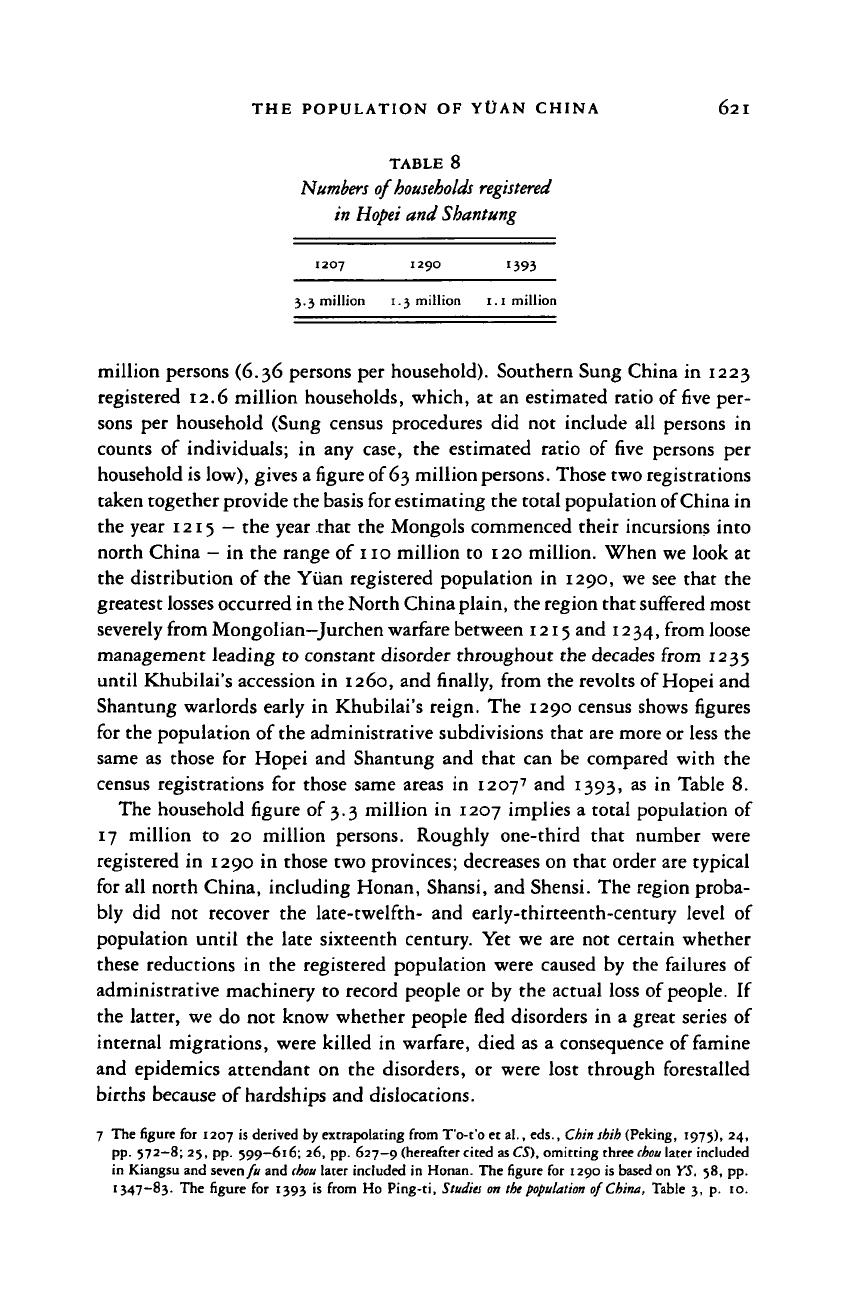
THE POPULATION OF YtJAN CHINA 621
TABLE 8
Numbers of households registered
in Hopei and Shantung
1207 1290 1393
3.3 million 1.3 million 1.1 million
million persons (6.36 persons per household). Southern Sung China in 1223
registered 12.6 million households, which, at an estimated ratio of five per-
sons per household (Sung census procedures did not include all persons in
counts of individuals; in any case, the estimated ratio of five persons per
household is low), gives a figure of 63 million persons. Those two registrations
taken together provide the basis for estimating the total population of China in
the year 1215
—
the year that the Mongols commenced their incursions into
north China
—
in the range of 110 million to 120 million. When we look at
the distribution of the Yuan registered population in 1290, we see that the
greatest losses occurred in the North China plain, the region that suffered most
severely from Mongolian-Jurchen warfare between 1215 and 1234, from loose
management leading to constant disorder throughout the decades from 1235
until Khubilai's accession in 1260, and finally, from the revolts of Hopei and
Shantung warlords early in Khubilai's reign. The 1290 census shows figures
for the population of the administrative subdivisions that are more or less the
same as those for Hopei and Shantung and that can be compared with the
census registrations for those same areas in 1207
7
and 1393, as in Table 8.
The household figure of 3.3 million in 1207 implies a total population of
17 million to 20 million persons. Roughly one-third that number were
registered in 1290 in those two provinces; decreases on that order are typical
for all north China, including Honan, Shansi, and Shensi. The region proba-
bly did not recover the late-twelfth- and early-thirteenth-century level of
population until the late sixteenth century. Yet we are not certain whether
these reductions in the registered population were caused by the failures of
administrative machinery to record people or by the actual loss of people. If
the latter, we do not know whether people fled disorders in a great series of
internal migrations, were killed in warfare, died as a consequence of famine
and epidemics attendant on the disorders, or were lost through forestalled
births because of hardships and dislocations.
7 The figure for 1207 is derived by extrapolating from T'o-t'o et al., eds., Chin shih (Peking, 1975), 24,
pp.
572-8; 25, pp. 599—616; 26, pp. 627—9 (hereafter cited asCT), omitting three
chou
later included
in Kiangsu and seven fu and
chou
later included in Honan. The figure for 1290 is based on YS. 58, pp.
1347-83.
The figure for 1393 is from Ho Ping-ti, Studies on
the population
of China, Table 3, p. 10.
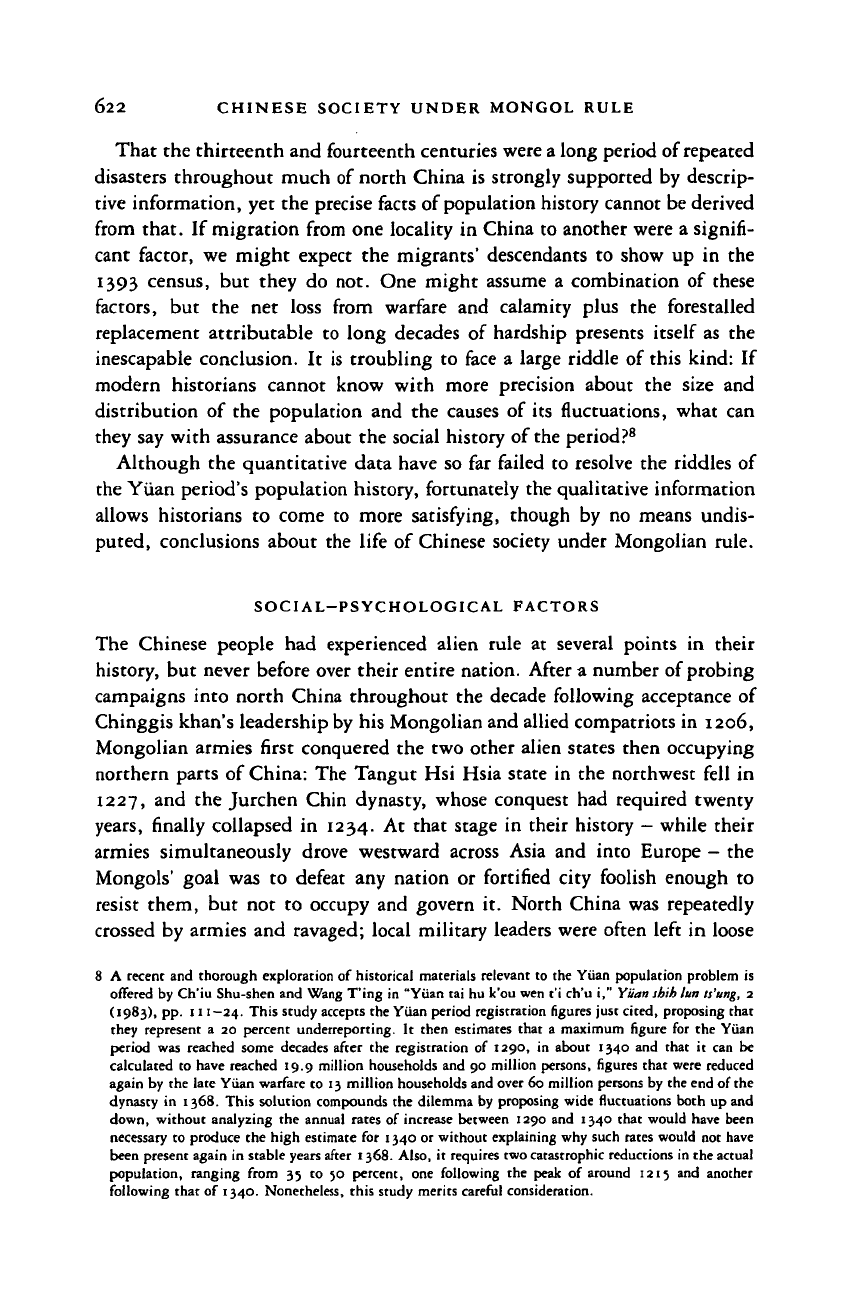
622 CHINESE SOCIETY UNDER MONGOL RULE
That the thirteenth and fourteenth centuries were a long period of repeated
disasters throughout much of north China is strongly supported by descrip-
tive information, yet the precise facts of population history cannot be derived
from that. If migration from one locality in China to another were a signifi-
cant factor, we might expect the migrants' descendants to show up in the
1393 census, but they do not. One might assume a combination of these
factors, but the net loss from warfare and calamity plus the forestalled
replacement attributable to long decades of hardship presents itself as the
inescapable conclusion. It is troubling to face a large riddle of this kind: If
modern historians cannot know with more precision about the size and
distribution of the population and the causes of its fluctuations, what can
they say with assurance about the social history of the period?
8
Although the quantitative data have so far failed to resolve the riddles of
the Yuan period's population history, fortunately the qualitative information
allows historians to come to more satisfying, though by no means undis-
puted, conclusions about the life of Chinese society under Mongolian rule.
SOCIAL-PSYCHOLOGICAL FACTORS
The Chinese people had experienced alien rule at several points in their
history, but never before over their entire nation. After a number of probing
campaigns into north China throughout the decade following acceptance of
Chinggis khan's leadership by his Mongolian and allied compatriots in 1206,
Mongolian armies first conquered the two other alien states then occupying
northern parts of China: The Tangut Hsi Hsia state in the northwest fell in
1227,
and the Jurchen Chin dynasty, whose conquest had required twenty
years,
finally collapsed in 1234. At that stage in their history
—
while their
armies simultaneously drove westward across Asia and into Europe
—
the
Mongols' goal was to defeat any nation or fortified city foolish enough to
resist them, but not to occupy and govern it. North China was repeatedly
crossed by armies and ravaged; local military leaders were often left in loose
8 A recent and thorough exploration of historical materials relevant to the Yuan population problem is
offered by Ch'iu Shu-shen and Wang T'ing in "Yuan tai hu k'ou wen t'i ch'u i," Yuan sbih lun
ts'ung,
2
(1983),
pp. 111—24. This study accepts the Yuan period registration figures just cited, proposing that
they represent a 20 percent underreporting. It then estimates that a maximum figure for the Yuan
period was reached some decades after the registration of 1290, in about 1340 and that it can be
calculated to have reached 19.9 million households and 90 million persons, figures that were reduced
again by the late Yuan warfare to 13 million households and over 60 million persons by the end of the
dynasty in 1368. This solution compounds the dilemma by proposing wide fluctuations both up and
down, without analyzing the annual rates of increase between 1290 and 1340 that would have been
necessary to produce the high estimate for 1340 or without explaining why such rates would not have
been present again in stable years after 1368. Also, it requires two catastrophic reductions in the actual
population, ranging from 33 to 50 percent, one following the peak of around 1215 and another
following that of 1340. Nonetheless, this study merits careful consideration.
